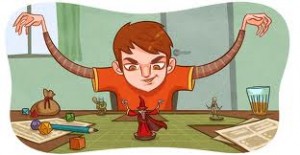 Everyone wants to be the best DM possible. They want to give their players the experience of a lifetime, every time. People create their own adventure, because modules – well can be a little dry and linear at times. I am not bashing modules, modules can be quite interesting for basic playing. Unfortunately, they tend not to provide the depth that serious role-players crave.
Everyone wants to be the best DM possible. They want to give their players the experience of a lifetime, every time. People create their own adventure, because modules – well can be a little dry and linear at times. I am not bashing modules, modules can be quite interesting for basic playing. Unfortunately, they tend not to provide the depth that serious role-players crave.
When creating your own adventures, some people tend to take it too far, trying to think of every detail, trying to predict every players’ actions, trying to look at the adventure from every different angle. If you have played and RPG long enough you should know that you cannot predict everything that you player characters are going to do. Here are some stress-free tips on preparing your adventures.
Character Backgrounds
One of the most important things you should do before beginning an adventure is to let your players help you plan the adventure. You can do this by asking them all for a character background. The character background will give you ideas and allow your creative juices to flow. Characters will give you an idea of their motivations, reasons for adventuring, NPCs that may influence the plot as you go up in levels. A players’ family member may be afflicted by lycanthropy, or some baron has unlawfully imprisoned your family. Perhaps a player character owes some gambling debts and the person they owe sends henchmen to collect what is owed. The possibilities are limitless.
The character background will also give you settings to place your characters in. Maybe you are situated in Eberron and the character is a refugee family from Cyre, living in New Cyre and the Blades are planning an attack on the town. Again, it gives you direction for adventures.
Loosely Plan Encounters
You don’t know what choices the party is going to make, and to railroad the players is not something I myself enjoy when a DM does this to me. Give yourself a general plan on how you think things will run and choose a few appropriate adversaries to suit your need for the coming encounters. This way if the characters decide to go left, when you planned to go right, you will be able to quickly plan something and adapt to the decisions of the players around your table.
Print off traps and hazards to pop into encounters. This takes away some of the pressure of having to take the extra time to choose appropriate monsters on the fly. Add some puzzles and contests to your repertoire. If you are like me, your players like the odd challenge and puzzle. It takes away from the monotony of battle after battle and provides a chance for your players to work cooperatively to solve encounters – not with muscles, but with brains. Go online, search for puzzles and riddles you can use as encounters. I once had a DM who set up a room where the party faced off against the top 5 chess pieces in a room. It was amazing.
Visual Representation
I think most players like to see what they were fighting. Grab some minis to represent the people the players are fighting. It gives a little more reality to the situation. You can also use tiles, or even a battle mat to plan the rooms. This way you can draw whatever sized rooms you need for all the encounters.
NPCs
Returning to the character backgrounds, use their backgrounds to give life to some of the influential persons in their lives. Your players will be incredibly surprised with their appearance in your gaming sessions – not only as a cameo, but a fleshed out power toting version of the people in their lives.
Apart from the character backgrounds, create a few NPCs for future use. Some of the NPCs should be those of disposable nature, ones that you can throw in for the adventure itself. Basic stats and a general appearance is all you would need for disposable NPCs.
There are a few things good NPCs should have to make them interesting. Write a character background for each of them. Do this either in great detail or point form; it doesn’t matter. Invent the NPC’s motivation, the reason for antagonizing your player; it will lead to the attitude you will attribute to the character during game play. Is the player surly, aggravating, invincible, arrogant etc. Give details to where they are from: location, career, position in enterprise. The characters will become that much more believable. Sketch out a general plan for the character’s future and see if it ties in with the party’s ambitions.
Next you should flesh them out. There are a couple of ways to achieve this. The easiest way is to take a monster or a character from the monster builder and modify it to suit your needs. Change the names of the powers and maybe add some of your own. The other way you could do this is to create them manually. Don’t forget to give them their strengths and weaknesses. They cannot all be perfect, no one is.
Lastly give your NPCs an appearance and a voice. What do they look like? Are they big, small, thin, muscular? How do they sound? Are they loud and boisterous, shy and mousy?
No matter what or how you decide to organize your adventure and encounters, don’t forget to have fun. Sometimes your player will throw a wrench into you plans – your counter is to not be so rigid. Be flexible in your planning and roll with the punches, you will see that not only you, but your players will get great enjoyment out of your improvisation.
If you can think of anything else (tips or tricks) to add to the list drop us a comment.


These are some really good tips. I’ll try to use some of these the next time i dm. THX!
Alton, we definitely see eye-to-eye on this one. I used to be of the plan-it-all out train of thought, but after seeing my carefully laid out plans thwarted time and time again, I have opted for the less is more approach.
A couple pages of bullet notes and ton of improvisation is all i need anymore and that ability to react to everything the players throw at me, without ever telling them “no” is a far more entertaining way to play, in my humble opinion.
The only one of your suggestions I haven’t started with yet, is the use of minis. This isn’t out of a lack of desire (I love minis… especially WarMachine…), but more due to the lack of decent models for Shadowrun.
A really good article for GMs looking to carve a gaming empire for themselves. 🙂
J.
Thanks for the feedback Jason, and as I read your article and think of my gaming session last night, I should kick myself in the head and use my own advice. LOL! We are playing 3.5 RttToEE and I reached a point where I am bored with the module and the play and reading your comment I said to myself: “screw this I am going to change it up for the rest of the module and do it my way, still keeping the general ideas of the module, but making it more fun for my players.
Keep gaming, it keeps us sane.
Alton.